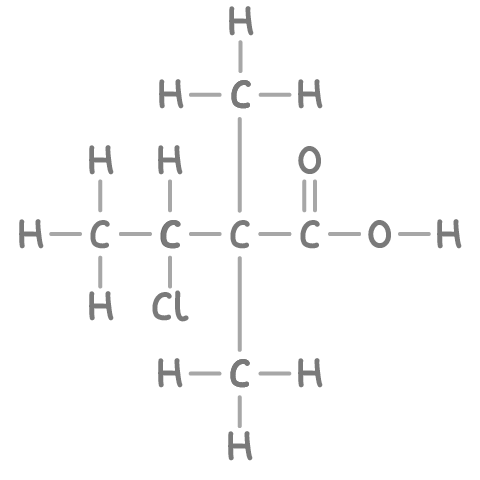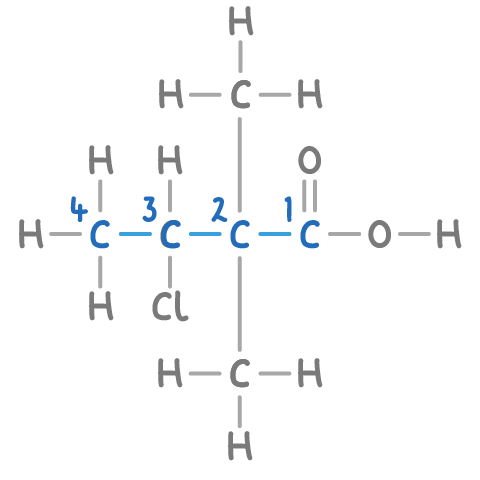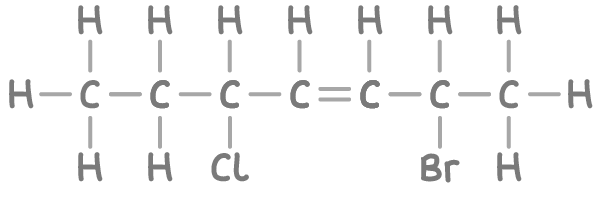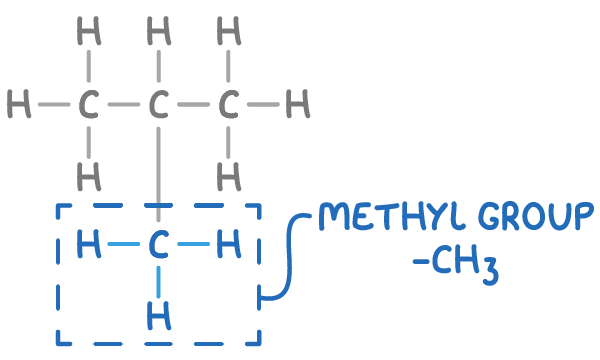Nomenclature - Naming Organic Compounds
This lesson covers:
- The meaning of nomenclature
- Naming organic compounds
What is nomenclature?
Nomenclature refers to the systematic method of naming chemical compounds in accordance with established rules. The IUPAC system is an internationally recognized set of guidelines for naming both organic and inorganic compounds. Understanding and applying these rules allows you to accurately name any organic molecule.
This lesson will guide you through the process of naming organic compounds using the following steps:
- Identifying the longest continuous carbon chain to determine the stem name.
- Recognising the key functional groups to determine suffix names.
- Numbering the carbon atoms based on the location of the functional group.
- Including numbers and prefixes for any side chains present.
- Applying multipliers like di-, tri-, and so on for multiple identical groups.
- Assembling the complete name by integrating all these elements.
Naming organic compounds
Step 1: Finding the base carbon chain
The first step in naming an organic molecule involves:
- Locating the longest continuous chain of carbon atoms that contains the primary functional group.
- The number of carbon atoms in this chain determines the stem name, as per the following table:
| Number of carbons | Stem name |
|---|---|
| 1 | Meth- |
| 2 | Eth- |
| 3 | Prop- |
| 4 | But- |
| 5 | Pent- |
| 6 | Hex- |
| 7 | Hept- |
| 8 | Oct- |
| 9 | Non- |
| 10 | Dec- |
For instance, in the illustrated compound below, the longest continuous carbon chain comprises 4 carbons, hence the stem name is but-.

Step 2: Identifying the functional group
The next step is to identify the key functional group, which typically provides the suffix of the compound's name. Here are some common functional group suffixes:
| Homologous series | Functional group | Suffix | Example |
|---|---|---|---|
| Alkane | N/A | -ane | Ethane, C2H6 |
| Alkene | C=C | -ene | Ethene, C2H4 |
| Alcohol | O-H | -ol | Ethanol, C2H5OH |
| Aldehyde | C=O | -al | Ethanal, CH3CHO |
| Ketone | C=O | -one | Propanone, CH3COCH3 |
| Carboxylic Acid | -COOH | -oic acid | Ethanoic acid, CH3COOH |
For example, the compound illustrated contains a carboxylic acid group (-COOH) on the first carbon, giving it the suffix -oic acid.

Step 3: Numbering the longest chain
The carbon atoms in the longest chain are numbered, with the primary functional group's carbon receiving the lowest possible number.
In our example, numbering the 4 carbon atoms with the -COOH group being assigned the lowest number results in a sequence from 1 to 4.

Step 4: Adding side chain prefixes
- Identify any side chains - these are smaller chains attached to the main carbon chain.
- Include these as prefixes in the name, indicating the carbon number to which they are attached.
- Arrange multiple side chains in alphabetical order.
In the compound shown, there is a chloro group on carbon 3 and methyl groups on carbon 2.

Step 5: Using multipliers
Use multipliers for multiple identical groups or side chains:
- di- for 2
- tri- for 3
- tetra- for 4
These multipliers do not affect the alphabetical order of the side chains.
In our example, the presence of two identical methyl groups is indicated by the prefix di-.

Step 6: Putting together the complete name
Combine all the information from the previous steps to name the compound systematically.
Thus, the compound's name is 3-chloro-2,2-dimethylbutanoic acid, comprising of:
- 3-chloro- = Chlorine atom on carbon 3
- 2,2-dimethyl- = Two methyl groups on carbon 2
- butan = Stem for 4 carbons
- oic acid = Carboxylic acid functional group
Worked example 1 - Naming an organic compound
Name the following compound.

Step 1: Finding the base carbon chain
The longest continuous carbon chain in this compound consists of 6 carbons, hence the stem name is hex-.
Step 2: Identifying the functional group
The compound contains a carboxylic acid group (-COOH), providing the suffix -oic acid.
Step 3: Numbering the longest chain
Number the chain from the end closest to the carboxylic acid group for the lowest numbering. This gives a sequence from 1 to 6.
Step 4: Adding side chain prefixes
- The compound has an ethyl group on carbon 4.
- There is also a methyl group on carbon 2.
Step 5: Using multipliers
This compound does not have multiple identical groups, so no multipliers are used.
Step 6: Putting together the complete name
- 4-ethyl- = Ethyl group on carbon 4
- 2-methyl- = Methyl group on carbon 2
- hex = Stem for 6 carbons
- oic acid = Carboxylic acid functional group
Therefore, the name of the compound is 4-ethyl-2-methylhexanoic acid.
Worked example 2 - Naming an organic compound
Name the following compound.

Step 1: Finding the base carbon chain
This compound's longest continuous carbon chain consists of 7 carbons, leading to the stem name hept-.
Step 2: Identifying the functional group
The compound has an alkene group (C=C) between carbons 3 and 4, resulting in the suffix -ene. It's important to indicate the position of the double bond.
Step 3: Numbering the longest chain
The chain is numbered to give the double bond and substituents (bromine and chlorine) the lowest possible numbers, resulting in a sequence from 1 to 7. The double bond is located between carbons 3 and 4.
Step 4: Adding side chain prefixes
- There is a bromine atom on carbon 2.
- A chlorine atom is attached to carbon 5.
Step 5: Using multipliers
There are no multiple identical groups, so multipliers are not needed.
Step 6: Putting together the complete name
- 2-bromo- = Bromine on carbon 2
- 5-chloro- = Chlorine on carbon 5
- hept = Stem for 7 carbons
- 3-ene = Alkene group starting at carbon 3
Therefore, the name of the compound is 2-bromo-5-chlorohept-3-ene.
Nomenclature - Naming Organic Compounds
This lesson covers:
- Key features that define a homologous series
- How to use general formulas to determine molecular formulas
- Common examples of important homologous series
- The structure of the carbon skeleton in organic molecules
Key features of a homologous series
Homologous compounds belong to a series of organic molecules that have the same general formula and similar chemical properties.
A homologous series has three distinctive characteristics:
- All members contain the same functional group. This specific group of atoms within a molecule is is repsonsible for the characteristic chemical reactions of that molecule.
- All memebers have the same general formula. This formula is a blueprint that can predict the molecular formula of any member in the series.
- Each subsequent compound in the series differs by a CH2 unit. This incremental addition of a CH2 group is what forms the next homologue in the series.
Determining molecular formulas
To determine the molecular formula of any member of a homologous series, you can apply its general formula. Here are two examples:
Worked example 1 - Calculating the molecular formula of an alkene
Calculate the molecular formula of an alkene with 7 carbon atoms.
Step 1: Identify the general formula for alkenes
The general formula for alkenes is CnH2n.
Step 2: Substitute the value for n (number of carbon atoms)
For an alkene with 7 carbon atoms, n = 7.
Step 3: Solve the formula to get the molecular formula
The molecular formula of the alkene = C7H2×7 = C7H14
Worked example 2 - Calculating the molecular formula of an alcohol
Calculate the molecular formula of an alcohol with 4 carbon atoms.
Step 1: Identify the general formula for alcohols
The general formula for alcohols is CnH2n+1OH.
Step 2: Substitute the value for n (number of carbon atoms)
For an alcohol with 4 carbon atoms, n = 4.
Step 3: Solve the formula to get the molecular formula
The molecular formula of the alcohol = C4H2×4+1OH = C4H9OH
Common homologous series
Here's a table outlining various homologous series, with examples for each:
| Series | Suffix/Prefix | Example |
|---|---|---|
| Alkanes | -ane | Propane (CH3CH2CH3) |
| Branched alkanes | Alkyl- | Methylpropane (CH3C(CH3)CH3) |
| Alkenes | -ene | Propene (CH3CH=CH2) |
| Haloalkanes | Fluoro- / Chloro- / Bromo- / Iodo- | Chloroethane (CH3CH2Cl) |
| Alcohols | -ol | Ethanol (CH3CH2OH) |
| Aldehydes | -al | Ethanal (CH3CHO) |
| Ketones | -one | Propanone (CH3COCH3) |
| Carboxylic acids | -oic acid | Ethanoic acid (CH3COOH) |
| Esters | Alkyl- oate | Ethyl ethanoate (CH3COOCH2CH3) |
| Amides | -amide | Ethanamide (CH3CONH2) |
| Acyl chlorides | -oyl chloride | Ethanoyl chloride (CH3COCl) |
| Arenes | -benzene / Phenyl- | Methylbenzene (C6H5CH3) |
Carbon skeletons in organic compounds
Organic compounds are built around a carbon skeleton, which is the backbone of the molecule. There are two primary types:
- Aromatic skeletons contain benzene rings, which are hexagaonal structures of carbon atoms with a ring of delocalised electrons.

2. Non-aromatic skeletons can be either:
- Straight-chained e.g. butane
- Branched e.g. 2-methylpropane
- Cyclic e.g. cyclobutane
Compounds are also classified based on the types of bonds between carbon atoms:
- Saturated compounds have only single bonds between carbon atoms, like in alkanes.
- Unsaturated compounds contain double or triple bonds (C=C, C≡C), or are aromatic.
Finally, an alkyl group is a fragment of a molecule, a carbon chain with the general formula CnH2n+1.
For example, the methyl group (-CH3) is the smallest alkyl group, circled in the molecule below.
